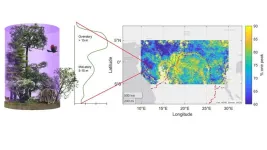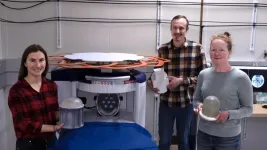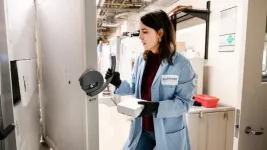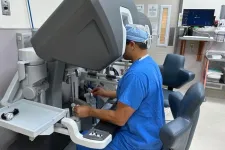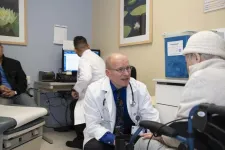(Press-News.org) We know less about the rainforest canopy, where most of the world’s species live than we do about the surface of Mars or the bottom of the ocean. However, that is about to change thanks to GEDI—a NASA space laser that has provided a detailed structure of the world’s rainforests for the first time ever.
“Tropical forests are mainly unstratified especially in Amazonia and regions with lower fertility or higher temperatures” reads the title of the recently published paper in Environmental Research Ecology that details the laser’s findings. Authored by researchers from the U.S., the U.K. and Singapore, Christopher Doughty, professor in NAU’s School of Informatics, Computing, and Cyber Systems and first author on the study, believes this research is crucial—and long overdue—in finding out more about the tropical ecosystems.
“Most of the world’s species live in tropical forests and most of those make use of the canopy, and yet, we know so little,” Doughty said. “Rainforest structure matters because it controls how animals access resources and escape predators, and these findings will help us understand tropical forest animal’s susceptibility to climate change.”
Research into forest canopies has come a long way. Early western visitors described tropical forests as horror vacui (nature abhorring a vacuum) since vegetation was “anxious to fill every available space with stems and leaves.” Later, as scientists began to study tropical forests, they categorized the lush flora into forest layers—a thick upper crown and a thick mid-layer with a thin layer in between. However, this was only observed in a few well-studied locations. The structure across most tropical forests was still unknown.
Then came GEDI, the Global Ecosystem Dynamics Investigation.
“A key difference between GEDI and many other satellites is its measurement of three-dimensional canopy structure,” said Hao Tang, professor in the Department of Geography at the National University of Singapore (NUS) and co-author on the paper. Tang, who is also a principal investigator at the NUS Centre for Nature-based Climate Solutions, added, “Conventional satellites, while providing valuable data on land cover and canopy greenness, often lack the detailed vertical information offered by GEDI. This vertical information is crucial for understanding ecosystem dynamics, carbon storage and biodiversity that cannot be easily seen from typical satellite images.”
Launched in late 2018, NASA’s GEDI shoots an invisible laser from the International Space Station into Earth’s forests thousands of times a day. Depending on the amount of energy returned to the satellite, it can provide a detailed 3D map that shows where the leaves and branches are in a forest and how they change over time. This will help researchers understand the amounts of biomass and carbon forests store and how much they lose when disturbed—vital information for understanding Earth’s carbon cycle and how it is changing.
Doughty, Tang and the other authors of the paper analyzed GEDI data across all tropical forests and found that the structure was simpler and more exposed to sunlight than previously thought. Data also revealed that most tropical forests (80 percent of the Amazon and 70 percent of Southeast Asia and the Congo Basin) have a peak in the number of leaves at 15 meters instead of at the canopy top, debunking the fullest-at-the-top theory of early researchers. While forests vary, a key finding that seemed to remain constant in every scenario was that deviation from more ideal conditions (like lower fertility or higher temperatures) leads to shorter, less stratified forests with lower biomass.
“It was really surprising to see the dominance of this structure type because it differs from what we had learned in the classic textbooks on the topic,” Doughty said. “These finding will not only help us understand how the millions of species that live in a rainforest canopy might acclimate to changing temperatures, but also how much carbon these forests hold and how good they are at fighting climate change.”
END
Into the unknown: NASA space laser provides answers to a rainforest canopy mystery
2023-07-18
ELSE PRESS RELEASES FROM THIS DATE:
Study finds tracking brain waves could reduce post-op complications
2023-07-17
CAMBRIDGE, MA -- When patients undergo general anesthesia, their brain activity often slows down as they sink into unconsciousness. Higher doses of anesthetic drugs can induce an even deeper state of unconsciousness known as burst suppression, which is associated with cognitive impairments after the patient wakes up.
A new study from MIT, in which the researchers analyzed the EEG patterns of patients under anesthesia, has revealed brain wave signatures that could help anesthesiologists determine when patients are transitioning into that deeper state of unconsciousness. This ...
New NIST measurements aim to advance and validate portable MRI technology
2023-07-17
Magnetic resonance imaging (MRI) machines can clearly view non-bony parts of the body — soft tissue such as the brain, muscles and ligaments — as well as detect tumors, making it possible to diagnose many diseases and other conditions. However, the powerful magnets in conventional MRI machines make them expensive and bulky, confining them mainly to hospitals and other large facilities.
As an alternative solution, companies are developing new portable versions that have lower-strength magnetic fields. These new models can potentially expand the ways in which MRI is used. For instance, low-field MRI systems could be deployed in ambulances ...
A key function for tight junctions in embryo models
2023-07-17
SAN FRANCISCO, CA—As a human embryo grows, a set of molecules directs cells as they multiply and take on specific identities and spatial positions within the embryo. In one crucial step known as gastrulation, these signaling molecules guide a single layer of embryonic stem cells to form three layers of distinct cell types that will later become different parts of the body.
Now, researchers in the iPS Cell Research Center at Gladstone Institutes have shown that tight junctions between cells may play a critical role in gastrulation in human embryos.
“This study has ...
COVID-19 case studies offer insights into what it will take to combat misleading medical information online
2023-07-17
1. COVID-19 case studies offer insights into what it will take to combat misleading medical information online
Health care leaders ‘take a shot’ at addressing viral medical rumors and disinformation
Abstract: https://www.acpjournals.org/doi/10.7326/M23-1218
URL goes live when the embargo lifts
A team of medical and public health leaders from the American Board of Internal Medicine, ABIM Foundation, and several respected institutions say COVID-19 case studies, among other ...
Rice engineers’ storage technology keeps nanosurfaces clean
2023-07-17
HOUSTON – (July 17, 2023) – Rice University engineers have created containers that can keep volatile organic compounds (VOCs) from accumulating on the surfaces of stored nanomaterials.
The portable and inexpensive storage technology addresses a ubiquitous problem in nanomanufacturing and materials science laboratories and is described in a paper published this week in the American Chemical Society journal Nano Letters.
“VOCs are in the air that surrounds us every day,” said study corresponding author Daniel Preston, an assistant professor in Rice’s Department of Mechanical Engineering. “They ...
Researchers discover group of genes that influence pain and brain communication can also influence alcohol use disorder risk
2023-07-17
INDIANAPOLIS—An estimated 16 million people in the United States have alcohol use disorders (AUDs), according to the National Institutes on Alcohol Abuse and Alcoholism (NIAAA). Now, Indiana University researchers have made a substantial discovery in the role genes play in the development of AUDs, finding that alteration of a group of genes known to influence neuronal plasticity and pain perceptions, rather than single gene defect, is linked to AUDs.
“We know inherited genes are a major contributor to this disease, because ...
MSK Research Highlights July 17, 2023
2023-07-17
New research from Memorial Sloan Kettering Cancer Center (MSK) and the Sloan Kettering Institute — a hub for basic science and translational research within MSK — identified a way to reduce toxicity in CAR T cell therapy; discovered a division of labor in DNA repair that suggests a possible therapeutic strategy for certain cancers; developed a new method to enable imaging of two PET tracers simultaneously; found biomarkers that could help predict outcomes in HER2-positive metastatic esophagogastric cancer; and made progress toward improving options ...
First robotic liver transplant in U.S. performed by Washington University surgeons
2023-07-17
A surgical team from Washington University School of Medicine in St. Louis recently performed the first robotic liver transplant in the U.S. The successful transplant, accomplished in May at Barnes-Jewish Hospital, extends to liver transplants the advantages of minimally invasive robotic surgery: a smaller incision resulting in less pain and faster recoveries, plus the precision needed to perform one of the most challenging abdominal procedures.
The patient, a man in his 60s who needed a transplant because of liver cancer and cirrhosis ...
Rice study: Men vastly outnumber women in studying legislative politics
2023-07-17
It’s no secret that men outnumber women in the halls of Congress and in other political arenas, but new research from Rice University, the University of Wisconsin-Madison and the University of Illinois Urbana-Champaign also found that significantly more men than women study the legislative process in the U.S. and abroad.
This has troubling implications for the inner workings of the discipline and the overall study of topics that impact women’s political involvement, according to Leslie Schwindt-Bayer, the Thomas Cooke and Mary Elizabeth Edwards Chair in Government and Democracy ...
City of Hope-led panel of experts updates cancer and aging guidelines issued by the American Society of Clinical Oncology
2023-07-17
LOS ANGELES — In an effort to improve treatment outcomes and quality of life for older adults with cancer, researchers from City of Hope, one of the largest cancer research and treatment organizations in the United States, and colleagues across the country today released updated guidelines by the American Society of Clinical Oncology (ASCO) outlining the need to assess and manage vulnerabilities in patients aged 65 and older prior to prescribing chemotherapy, targeted therapy and/or immunotherapy.
The updated recommendations, published in the Journal of Clinical Oncology, urges the clinical use of a validated geriatric assessment (GA) — defined as an evaluation ...
